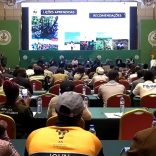Mozambique may uncover more ‘ghost workers’, finance minister warns - Watch
Population Census “an indispensable tool” for development – Minister of Finance

File photo
The Mozambican Minister of Economy and Finance, Adriano Maleiane, declared on Monday that the population census scheduled for August 2017 is an indispensable tool for drawing up, implementing and monitoring national development programmes.
Speaking in Maputo, at the opening of an Expanded Consultative Council of the National Statistics Institute (INE), Maleiane said the 2017 census “is the priority of priorities for the entire national statistical system. To implement the census, the government will give all necessary support, and calls on all national and international partners to join their efforts to ensure success”.
The census, Maleiane added. “is an initiative of vital importance in order to understand reality. Its strategic objective is to satisfy the needs for demographic, economic and social information required for drawing up development plans and programmes”.
The population census, Maleiane continued, is the basis for all other surveys undertaken by the INE – such as the household budget surveys, the national accounts, and the consumer price indices.
Other challenges facing the INE, the Minister said, were to strengthen the coordinating role of the Higher Statistics Council, to revive statistics units in all ministries, and to strengthen the INE’s own provincial delegations in producing and disseminating provincial and district statistics.
A further need is to improve the Consumer Price Indices used to calculate the rate of inflation. Currently the consumer price indices are only available from the three largest cities (Maputo, Nampula and Beira). Maleiane wanted to see the INE produce Consumer Price Indices from all provincial capitals.
Since independence, Mozambique has carried out three population censuses – in 1980, 1997 and 2007. Based on projections from the 2007 census, the INE estimates the current population of Mozambique at 26.4 million. The country is still overwhelmingly rural, with 17.9 million people living in the countryside, and 8.5 million living in urban areas.











Leave a Reply
Be the First to Comment!
You must be logged in to post a comment.
You must be logged in to post a comment.